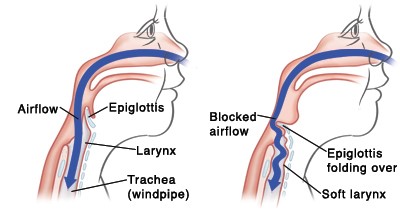What is laryngomalacia?
Laryngomalacia is a condition that affects the voice box structures, also known as larynx. Tissue above the voice box, including the epiglottis, protects against food and liquid from going through the voice box, and into the lungs. However, if the tissue is too floppy, it may fall over the airway opening and block part of it. This causes noisy breathing called stridor. The condition usually corrects itself as a child grows but may last until 1½ years of age.
What causes it?
The cause is not known, but it is often present at birth. It may be due to muscles that are not fully developed. It could be from an underdeveloped nervous system in that area.
What are the symptoms?
The symptoms can start within the first two weeks of life, but can show up as late as 1½ years of age. The main symptom is noisy breathing when taking a breath in. The noise may get louder when your child cries, plays, feeds or sleeps on the back. Other symptoms may include:
- Difficult weight gain.
- Pauses in breathing.
- Problems with feeding such as choking or gagging.
- Spitting up food, called reflux.
- Vomiting.
- The skin around the neck or ribs pulling in when your baby breathes. This is called neck or chest retractions.
- Turning blue. This is called cyanosis.
The symptoms may get worse over the first few months. Most children will outgrow the noisy breathing by 12 to 18 months of age.
Some children with laryngomalacia also have Gastric Esophageal Reflux Disease (GERD). This is when spit up (reflux) travels from the stomach and into the mouth. It can cause the floppy tissue above the voice box to swell and make breathing sound even louder. Your child’s primary care doctor may need to prescribe medicine to treat GERD.
How is Laryngomalacia diagnosed?
The diagnosis is made in a number of ways:
- Your child’s signs and symptoms will be reviewed.
- A head and neck exam may be done. X-rays may be needed.
- A flexible laryngoscopy may be done. This is a procedure where a small, lighted tube (laryngoscope) is passed through the child’s nose. It lets the doctor look at all the structures above the voice box that may be causing breathing problems. The scope is connected to a TV camera so the parent or caregiver may see the problem. If your child has this procedure, nose medications may be given before it starts. If nasal medications are given, the team will let you know when your child may eat and drink.
- A sleep study may be ordered to check the breathing during sleep.
- A swallow study may be ordered if there is choking with feeding. This is a special x-ray that checks if liquids go into the windpipe when drinking.
Bring your child to the hospital Emergency Room if:
- Breathing stops for more than 10 seconds.
- If your child gets gray or blue around the lips.
- If your child’s skin between the ribs or neck pulls in and it doesn’t get better after changing their position.



